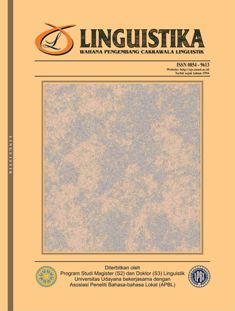PERAN SEMANTIS DALAM KONSTRUKSI DATIF BAHASA JEPANG
Abstract
This study aims to describe the verbs that give rise to dative construction and the semantic roles that arise in dative construction in Japanese sentence structure, which includes the agentif role, benefactive role, experience role, and objective role. The theory used in this study is the theory of Givon (2001), Cook's Case Grammar Theory (1979), and the theory of inheritance from Nitta (1991). Data sources are taken from the Japanese corpus, www.kotonoha.gr.jp/shonagon/
This research shows Japanese language is a language marked or a file. The case in Japanese here is closely related to the system of inheritance in the Japanese sentence structure. The marker is attached after noun (noun). The markers or particles that state direct objects are accusative markers 'o' and markers datif 'ni' as markers of indirect objects. The verb found in this study is tatakareta 'has been tapped', yonde kureta 'has read', tooraseta 'has (caused) passed', and oboeta 'has remembered' which can bring up multiple objects, namely the order of direct objects and indirect objects. The results of this study, (1) show the verbs that allow the emergence of multiple objects, especially indirect objects (IO) in the construction of Japanese, are transitive verbs or action verbs and intransitive verbs in the form of idou doushi 'moving verbs' are causative in Japanese language {~ exciting / ~ saseru} means to make / cause, and (2) the semantic roles that arise in the dative construction of Japanese sentence structures (BJ) include (a) agentive roles, (b) benefactive roles, (c) experience roles, and (c) objective roles. Semantically the verbs that give rise to the semantic role are keizoku doushi 'continuous verbs' and shunkan doushi 'pungtual verbs'.













